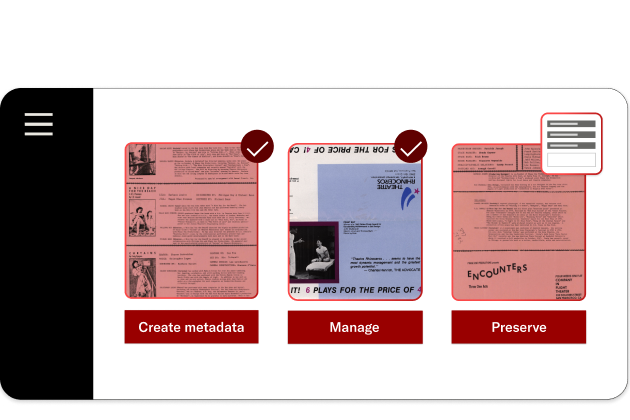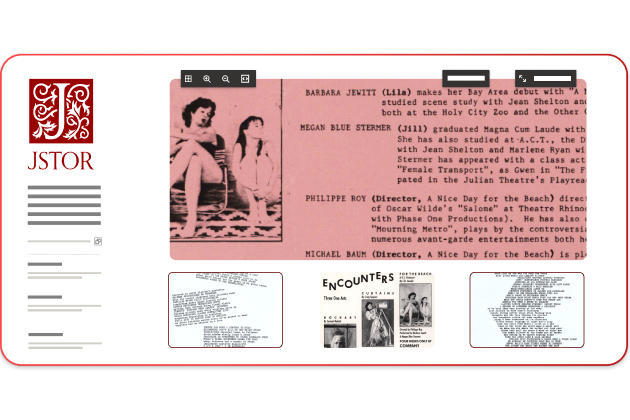Next-generation integration: Rethinking digital collection stewardship from start to finish
In over a decade and a half working in the digital collections space, I’ve consistently heard two core challenges from stewards of archives and special collections. First, there’s too much content and not enough resources to handle it. Second, tools tend to be fragmented, making it hard to work seamlessly across the full lifecycle of digital collection management.
These two issues compound each other. Even if a tool speeds up one step, a lack of integration creates friction, inefficiency, and frustration in an already overwhelmed stewardship pipeline.
We heard these frustrations from our community, and responded by developing JSTOR Digital Stewardship Services. Designed in collaboration with archivists and librarians, this integrated, practitioner-informed platform is more than just a collection of tools, and more flexible than a rigid, all-in-one system. It directly addresses the challenges of scale and fragmentation.
With the help of JSTOR Seeklight, our new, AI-powered technology, Digital Stewardship Services tackles the problem of volume by rapidly generating high-quality, reviewable metadata. At the same time, the platform supports a unified workflow, from processing to discovery to preservation, while still offering flexibility.
This post offers a look at our integrated approach: Why it’s different, how we built it, and why it matters to your work.
Fragmentation and inundation: An intersection of common pain points
For years, fragmentation has been the norm in digital collections stewardship, with institutions often needing to juggle multiple tools and platforms: one for metadata, another for publishing, another for storage, another for preservation, and so on. To make them work together, you need technical staff, developer time, and ongoing resources for integration and maintenance. It’s expensive, and it can be fragile.
Some institutions can build and sustain those kinds of bespoke systems. Many can’t. And for those that try, the workarounds and patches can add up. Even choosing a hosted solution doesn’t always simplify things, because most focus on only one or two pieces of the puzzle, leaving the library to stitch together the rest. And with the rapid growth of born-digital content and new formats, the pressure on already strained systems continues to rise.
Over the years, the intertwined issues of fragmentation and resource constraints have sometimes felt insurmountable. Any solution robust enough to address the full scope of stewardship needs was at risk to become too monolithic and rigid to accommodate the diverse workflows of real institutions, while additional tools would only add to the noise.
Through deep collaboration with practitioners, combined with the insights and infrastructure JSTOR has developed over decades, we realized that the answer wasn’t consolidation or further fragmentation. It was integration.
Integration that works like you do
At JSTOR, we’ve spent the past 30 years developing solutions with, and for, the scholarly community. In doing so, we’ve built trusted, time-tested systems that are purpose-built to address specific challenges.
Looking at our array of infrastructure, we saw an opportunity to take a different approach on addressing current issues in stewardship. One that respects the need for interoperability while still delivering a unified user experience. That meant thinking differently about how our services are designed, and how they work together. Each part of our platform is built to serve a specific function:
- JSTOR Seeklight for intelligent metadata generation
- Cataloging tools (formerly JSTOR Forum) for organizing and describing items
- JSTOR for discovery and access
- Portico for long-term digital preservation
What makes our approach unique is that these tools are fully integrated, and designed to be used together or individually.
If you only want to generate metadata and collection intelligence with JSTOR Seeklight and export it elsewhere, you can. If you want to catalog and preserve but not share content to JSTOR, that’s fine too. If you want a fully integrated experience from start to finish, it’s all there, ready to work together, without the need for costly, time-consuming integrations.
Each component is excellent at what it does, but when used together, they create something much more powerful: a connected environment that reflects the real-world complexity of digital stewardship.
Built with practitioners, for practitioners
In developing JSTOR Digital Stewardship Services, we conducted interviews, site visits, and user testing sessions with archivists, librarians, and digital collection managers. We looked closely at their current workflows, pain points, and priorities, developing key takeaways that informed what we built:
- Support outcomes, don’t prescribe workflows. Practitioners told us they didn’t want a system that imposed a rigid order of operations, they simply wanted one that helped them accomplish their goals. Workflows in stewardship are rarely linear. Sometimes you start with preservation, sometimes you’re focused on access, and sometimes you need to circle back and reprocess or enrich metadata. Our system is built to accommodate this reality, with intuitive navigation and flexible functionality to let users move seamlessly between stages, in whatever order makes sense.
- Respect the human role. All aspects of our Stewardship platform put the people doing the work front and center. That’s especially true of JSTOR Seeklight, our most tech-forward tool. Rather than replacing human expertise, this AI-powered processing tool is designed to amplify it, delivering a high-quality first pass of metadata so professionals can better focus their time and knowledge. We’ve equipped JSTOR Seeklight with intuitive capabilities for reviewing and editing, and we tag all AI-generated metadata to ensure full transparency for today’s users, and future researchers.
- Preservation in the loop. Digital preservation is another area where integration matters. It isn’t well understood, and it can be hard to get a sense of what’s needed, and how to make it work. It’s also another area where JSTOR offers something unique. Through Portico, we offer what I call “legit preservation,” meaning it’s much more than storing multiple backup copies. It creates archival information packages, conducting fixity checks, supporting format migration when needed, and preserving content in geographically distributed locations.
In short, it’s professional-grade preservation that institutions can trust. And it’s built right into the JSTOR stewardship platform. You don’t need to set up a separate contract or workflow to ensure your content will be preserved. It’s part of the offering. We even had to develop protocols for “un-preservation” (yes, really), because Portico is built to hold content in a truly durable, irreversible way.
Building for trust in uncertain times
Fragmentation isn’t new, and neither are budget constraints. But in today’s climate, uncertainty feels more intense than ever. Institutions face real questions about where funding will come from, how long it will last, and what systems will still be supported five years down the line.
In this context, JSTOR is offering something rare: a reliable, mission-aligned solution, engineered to last. Because we’re a nonprofit, our priority isn’t shareholder value: it’s community impact. We can afford to think long-term, invest in sustainable development, and prioritize user needs over flash or hype.
We’re building our infrastructure accordingly. Behind the scenes, we’re using micro frontends (MFEs) and modular architectures to make our platform more maintainable and extensible. That might sound technical, but the benefit is simple: it means we can grow and adapt over time, without sacrificing performance or usability.
When we think about what JSTOR Digital Stewardship Services offers, we often focus on features. But at the end of the day, what we’re really offering is trust:
Trust that your materials will be preserved.
Trust that your staff will be supported.
Trust that our tools will keep evolving with your needs.
We know this space. We’ve been supporting digital collections for decades, and have built JSTOR Digital Stewardship Services in collaboration with the people who are doing the work, day in and day out.
So whether you’re looking to reduce backlog, improve discoverability, consolidate platforms, or prepare for the unknown, we’re here for the long haul. And we’re excited to keep building together.
Explore JSTOR Digital Stewardship Services to see how an integrated, practitioner-informed platform can help you process, manage, preserve, and share your digital collections with flexibility and trust.
Related reading
About the author

Ann Connolly has been supporting libraries for over 15 years, first at bepress Digital Commons and, most recently, as Senior Product Manager with ITHAKA. Her work over that time has encompassed a variety of topics, including open access, research impact, collection development policies, copyright and authors’ rights, and preservation. She currently co-leads efforts in developing products and services that address needs across the spectrum of collection stewardship activities.

